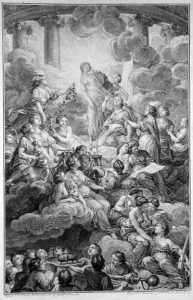24 INTRODUCTION TO THE 18th CENTURY
The 18th century is frequently referred to as both the Age of Enlightenment and the Age of Revolutions. The world was transformed in this century by changes in political thought that expressed themselves in revolutions and by technological developments that allowed for new ways of manufacturing products. In many respects, the Enlightenment can be seen as an extension of the basic insights of the Scientific Revolution. In the 17th century, scientists had asserted that the natural world could be best understood through the use of human reason. Sir Isaac Newton and others asserted that the universe was governed by natural laws like gravity. In the late 17th century and into the 18th century, writers and thinkers began to apply the principle of reason to the world of human interactions (politics). Scientists had demonstrated that many of the old ways of thinking about the natural world were incorrect. Philosophers began to advance the revolutionary idea that the old ways of thinking about politics were also wrong. During this Age of Reason, philosophers like John Locke in England and Voltaire in France used reason to critique the idea that kings ruled by divine right. Instead, they argued that the right to rule came from the people. They asserted that all people were equal by virtue of their shared humanity and possessed “natural rights” which must be acknowledged by those in power. Although Enlightenment thinkers frequently disagreed with each, they were united in believing that human beings could transform their world and create a better one through the use of reason
The consequence of these ideas was manifested in political revolutions that occurred in the latter half of the 18th century. In what would become the United States, the political leaders of the English colonies came together to overthrow what they perceived to be the tyranny of the King of England. The French overthrew a king they considered to be out of touch with their needs and established a new government more in touch with the people and their concerns. Slaves in Haiti overthrew their masters to form the world’s first nation led by those who had been formerly enslaved. Although, as we shall see, radically different in many ways, these three revolutions shared one thing in common: they were inspired by the ideas of the Enlightenment.

Another kind of revolution began to take shape in the late 18th century as well. This too was inspired by the ideas of the Enlightenment as well as the insights of the Scientific Revolution. The philosopher Adam Smith applied reason to the realm of economics. In 1776, he published The Wealth of Nations in which he argued against the established economic theory of mercantilism. Smith argued that rulers should stop trying to control their nation’s economies by regulating imports and exports. Instead, they should allow people to freely exchange goods and trust the “free market” to regulate itself. Advances in 18th century technology created a climate in which Smith’s ideas could flourish. The invention of the steam engine was the catalyst for the implementation of the factory system. Goods that had previously been made by hand in homes could now be mass-produced by machines in factories. These goods could then be transported more quickly for less cost by railroads and ships powered by the same steam engines. The Industrial Revolution began in the textile industry in England in the late 18th century and spread to other nations in the 19th.
Thus, by the end of the 18th century, people’s lives had been radically transformed in many parts of the world. Political revolutions in the Americas and Europe offered many an opportunity to govern themselves. The establishment of the factory system brought many from farms to live in rapidly expanding cities. This same system did much to destroy the previous household economy by transforming people in wage-laborers who worked for others. At the same time, it should be noted that for the vast majority of the world’s peoples, much remained the same. War and social conflict brought hardships and suffering to many. The African slave trade, begun in the 17th century, intensified in the 18th as more than six million Africans were ripped from their homes, robbed of both their freedom and dignity, and forced to work for others. The subjugation of the indigenous peoples of the Americas intensified as English colonists built homes and farms on land forcibly taken from those who had lived there for centuries. Women continued to be oppressed throughout the world and, even in those parts of the world which had experienced political revolutions, were denied political and legal rights. Finally, the Industrial Revolution which did much to transform human existence did little to create a more equal and just economic world. The rich grew wealthier as the poor became poorer.
In this chapter, we will seek to understand all that has been mentioned above. Our study begins by looking at the various regions of the world in the 18th century. The initial “global overview” discusses important rulers, cultural trends, and developments that impacted the lives of people. The remaining sections of this chapter focus on important connections between ideas and events by examining the Political and Social Impact of the Enlightenment and the Industrial Revolution.
